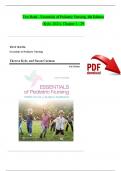Exam (elaborations)
TEST BANK - Essentials of Pediatric Nursing 4th Edition By Theresa Kyle, Susan Carmen, All Chapters 1 - 29, Complete Newest Version
TEST BANK - Essentials of Pediatric Nursing 4th Edition By Theresa Kyle, Susan Carmen, All Chapters 1 - 29, Complete Newest Version TEST BANK - Essentials of Pediatric Nursing 4th Edition By Theresa Kyle, Susan Carmen, All Chapters 1 - 29, Complete Newest Version TEST BANK - Essentials of Ped...
[Show more]



